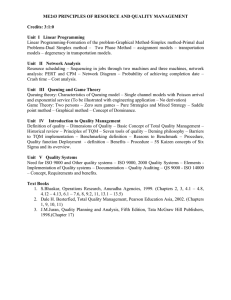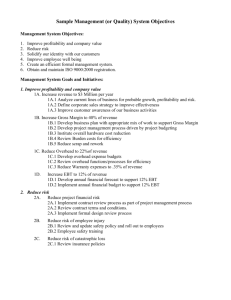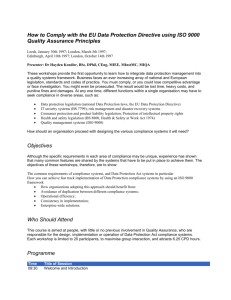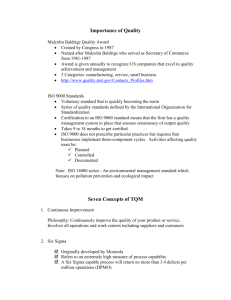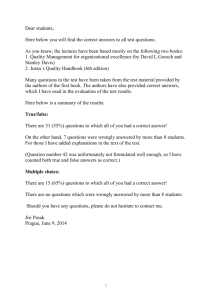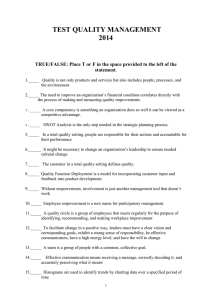ISO 9000 C ERTIFICATION
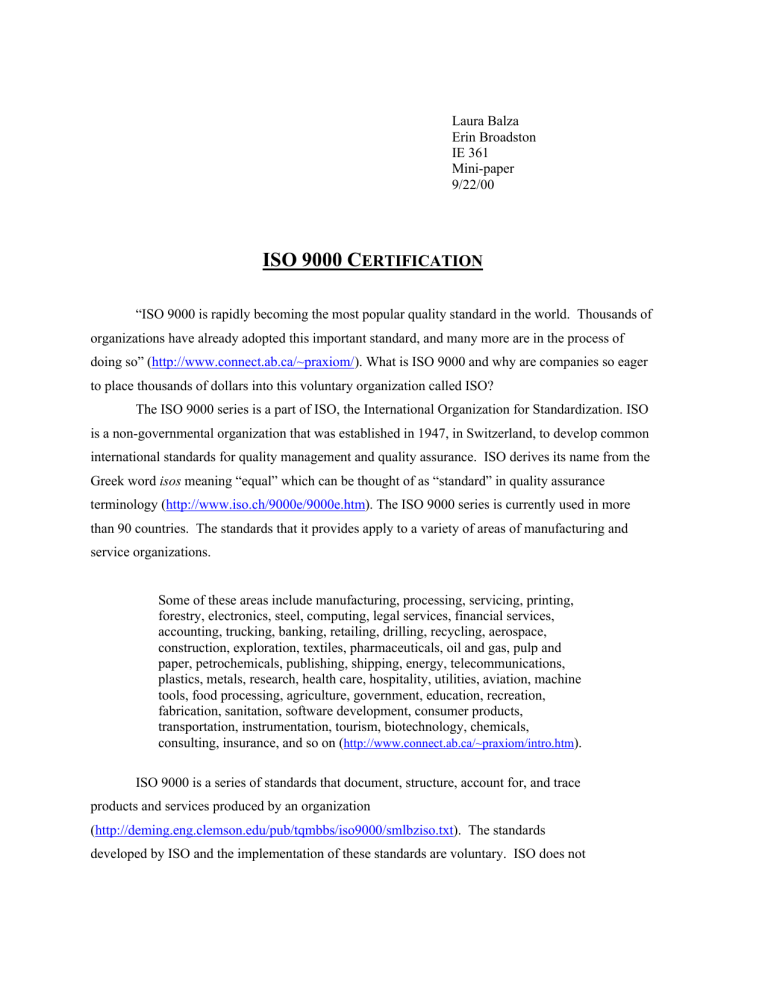
Laura Balza
Erin Broadston
IE 361
Mini-paper
9/22/00
ISO 9000 C
ERTIFICATION
“ISO 9000 is rapidly becoming the most popular quality standard in the world. Thousands of organizations have already adopted this important standard, and many more are in the process of doing so” ( http://www.connect.ab.ca/~praxiom/ ). What is ISO 9000 and why are companies so eager to place thousands of dollars into this voluntary organization called ISO?
The ISO 9000 series is a part of ISO, the International Organization for Standardization. ISO is a non-governmental organization that was established in 1947, in Switzerland, to develop common international standards for quality management and quality assurance. ISO derives its name from the
Greek word isos meaning “equal” which can be thought of as “standard” in quality assurance terminology ( http://www.iso.ch/9000e/9000e.htm
). The ISO 9000 series is currently used in more than 90 countries. The standards that it provides apply to a variety of areas of manufacturing and service organizations.
Some of these areas include manufacturing, processing, servicing, printing, forestry, electronics, steel, computing, legal services, financial services, accounting, trucking, banking, retailing, drilling, recycling, aerospace, construction, exploration, textiles, pharmaceuticals, oil and gas, pulp and paper, petrochemicals, publishing, shipping, energy, telecommunications, plastics, metals, research, health care, hospitality, utilities, aviation, machine tools, food processing, agriculture, government, education, recreation, fabrication, sanitation, software development, consumer products, transportation, instrumentation, tourism, biotechnology, chemicals, consulting, insurance, and so on ( http://www.connect.ab.ca/~praxiom/intro.htm
).
ISO 9000 is a series of standards that document, structure, account for, and trace products and services produced by an organization
( http://deming.eng.clemson.edu/pub/tqmbbs/iso9000/smlbziso.txt
). The standards developed by ISO and the implementation of these standards are voluntary. ISO does not
have any legislative power and is not a part of any government or the United Nations.
Governments as well as individual companies make the decision to voluntarily integrate
ISO standards into their systems on a voluntary basis.
Many companies choose to become ISO 9000 certified because customers expect quality products and services. According to FORTUNE magazine,
Many companies consider ISO 9000 more than a marketing tool and a minimum standard. By working through the ISO 9000 process, they have been able to compete for, and satisfy their customers more effectively”
( http://web.ansi.org/public/news/1998feb/fortune_17.html
).
Also, many companies decide to implement ISO 9000 to reduce costs related to quality problems such as after-the-fact inspections, warranty costs, and rework. ISO 9000 is also implemented to have an edge over the competition. A few governments require that some industries meet the international standards that ISO 9000 has created.
ISO 9000 is made up of a family of four quality assurance models that work to improve management practices. The quality assurance model family includes ISO 9001,
ISO 9002, ISO 9003, and ISO 9004. As a company begins to implement ISO 9000 and become ISO 9000 certified, it will choose which quality assurance model from the ISO
9000 family it wants to utilize based on the needs of the company. Each model is used for a different function within a company. These models are actually subsets of each other and it is possible for a company to use all of the quality assurance models. The certification process of ISO 9000 can take 12 to 18 months depending on which standard is registered ( http://deming.eng.clemson.edu/pub/tqmbbs/iso9000/smlbziso.txt
).
The ISO 9000 family can be described as follows:
• ISO 9001 is used when designing a product or service. It provides procedures for all processes associated with a product from product design to production to implementation and installation.
• ISO 9002 is implemented when a company manufactures a product using an item someone else designed. This means that the company purchases a product from another company to utilize in one of its own products. This process differs from 9001 in that it does not provide a guidance system for the design of a product. ISO 9002 is often utilized by service organizations.
• ISO 9003 provides guidance for final production and test of a product only.
A company should utilize ISO 9003 when final production and test are the main function of the company’s production system.
• ISO 9004 is used internally when the company is developing its own quality assurance program to meet business needs and to get an edge over the competition.
The implementation of any of these models begins with the definition of the company’s attitude toward quality and forms the company’s quality policy. Once this is complete, the company will create and define a quality team and the quality team’s responsibilities. Resources will be allocated so that the quality team can perform and verify the quality system at work. A quality manager will be given authority and course of action to review the effectiveness of the quality system.
Once the quality management team has been selected, the team will create the quality system for the company and create a manual that defines it. Once the quality system is determined, it will be implemented. Implementation includes developing the quality plans for the products the company makes, the processes the company uses, the projects the company takes on, and the contracts the company makes with its customers.
To insure the quality plans are followed, the company must also institute a documentation system, training program, and auditing plan.
After implementation, the company will contact an ISO 9000 registrar to become certified. The registrar will examine the company two ways. They will review the documentation system to ensure the documentation meets ISO 9000 standards. The registrar will then assess the site to make sure the company is in compliance with the aforementioned documentation system. After the registrar has finished the assessment, the company will be registered and become ISO 9000 certified. Customers will be able to confirm with the registrar that the company is certified. Every six months the company will be assessed to make sure that the company is maintaining its compliance with ISO 9000 standards. During these semi-annual assessments only 20 percent of the company will be checked at one time. By the third year, the entire company will have been covered to assure compliance with the ISO 9000 standards.
( http://www.sqa.org/overheads/1998/LDD.html
). The ISO 9000 program is an ongoing
process. Once ISO 9000 has been implemented, the company’s goal should be continuous improvement and continual customer satisfaction.
The initial cost of registering for ISO 9000 is rather high. According to
Distribution Quarterly ( http://www.internetstore.bc.ca/dci/dqvol2no4.htm
) "on average, companies pay a cost of $245,000 for the implementation and registration process. This includes auditing fees and internal expenses." However, this cost is usually recovered in approximately three years. Savings are also high for most companies once the ISO 9000 has been implemented. “Companies with annual sales of $11 million saved $25,000 a year. Companies with annual sales of $1 billion saved $532,000 per year”
( http://www.internetstore.bc.ca/dci/dqvol2no4.htm) . ISO 9000 improves not only overall quality of the company’s product, but also improves inventory turnover and on-time delivery. A company that implements ISO 9000 should expect an expansion into new markets and a larger markets share. By becoming ISO 9000 certified a company greatly improves its overall efficiency and will be recognized for its commitment to quality both nationally and internationally.
D
OCUMENTATION
ANSI Online. "ISO 9000 Focus of FORTUNE Special Section."
< http://web.ansi.org/public/news/1998feb/fortune_17.html
>
DeVincentis, Laura D., MPA "The Emerging Application of ISO 9000 in the Health Care Sector."
< http://www.sqa.org/overheads/1998/LDD.html
>
"Distribution Quality" < http://www.internetstore.bc.ca/dci/dqvol2no4.htm
>
"ISO 9000 Translated into Plain English” < http://www.connect.ab.ca/~praxiom/ >
"ISO, ISO 9000, ISO 14000" < http://www.iso.ch/9000e/9000e.htm
>
Richard L. Taylor, "Small Businesses should prepare; ISO 9000 is on the way."
< http://deming.eng.clemson.edu/pub/tqmbbs/iso9000/smlbziso.txt
>
